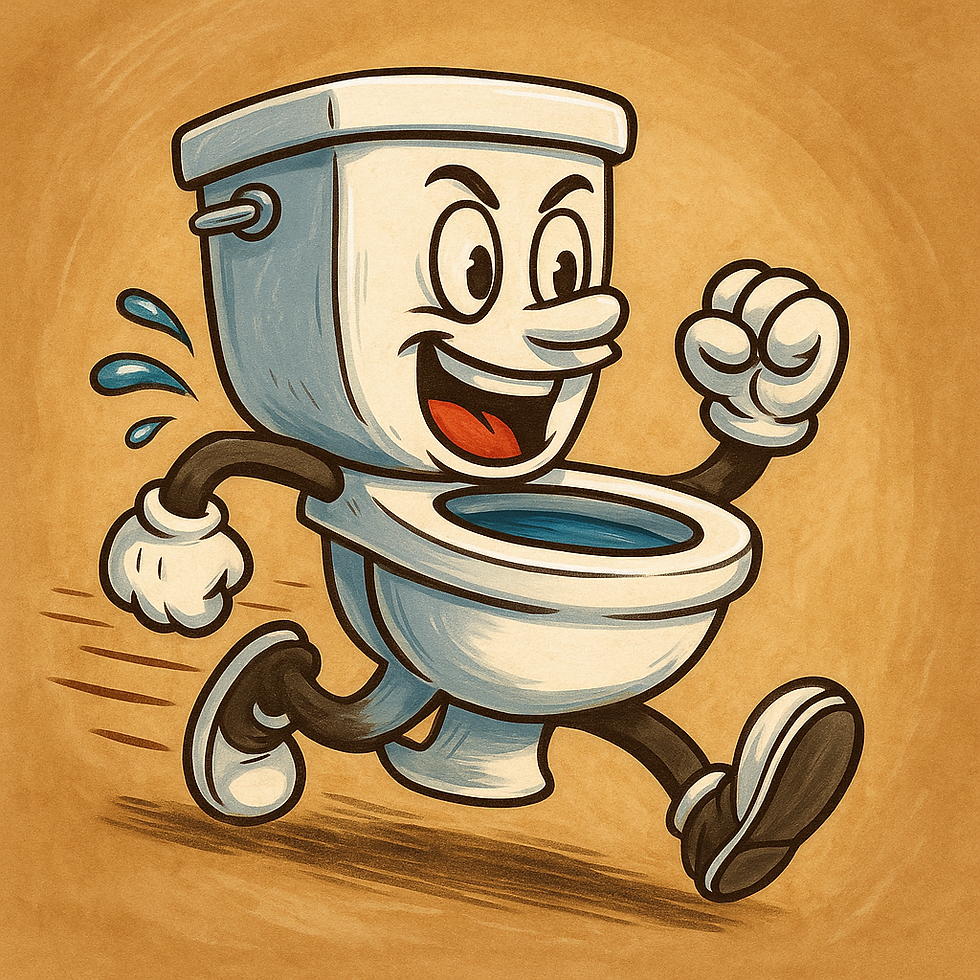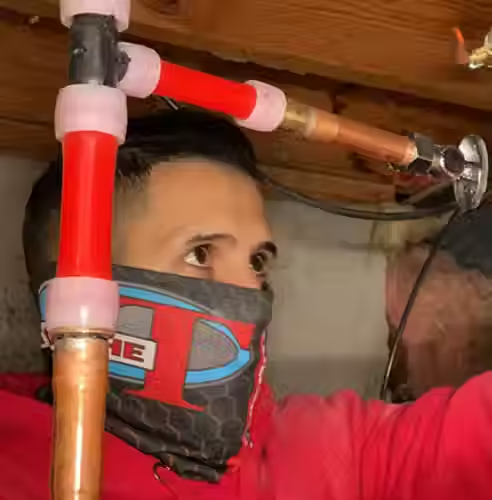How to Stop a Running Toilet
- Craftsman Network

- Aug 12
- 5 min read
A running toilet — one of the most common toilet problems — might not seem like a significant plumbing emergency. But it can waste hundreds of gallons of water a day, raising the water level in your toilet bowl and potentially causing excess water to overflow. Beyond the irritating sound, a constantly running toilet forces your home’s plumbing fixtures to work harder than they should. This can lead to water damage and higher utility bills.

The good news? Most DIY fixes are simple, inexpensive, and require minimal tools. Whether your commode is constantly running, you’ve noticed water from the tank trickling into the bowl, or your flush never seems to end, this guide will help you find the cause, make quick repairs, and know when it’s time to call a professional.
Common Causes of a Running Toilet
A running toilet is a common problem for homeowners and renters alike.
Here’s why it happens:
Worn-Out Flapper Seal
The flapper is the rubber stopper at the bottom of your tank. It controls the release of water during a flush. Over time, it can warp, crack, or lose flexibility, allowing water to leak from the tank into the toilet bowl.
Mineral buildup from hard water or water softeners can also prevent the flapper from sealing correctly. If you’ve repaired or replaced the flapper before, but the problem returns, debris lodged under the seal or a misaligned chain might be to blame.
Faulty Toilet Fill Valve
If your toilet fill valve is worn or damaged, it may allow excess water to flow into the tank indefinitely. This part regulates the amount of water that enters after a flush. A faulty fill valve often causes the water level to rise too high, spilling into the overflow tube and wasting water.
Improper Float Height
The float determines the water level in your toilet tank. If it’s set too high, water spills into the overflow tube. If it’s too low, your flush won’t clear the bowl. A misadjusted float can make it seem like your toilet is constantly running when it’s just refilling too often.
Other Plumbing Issues
While less common, a running toilet can also be linked to hidden plumbing issues. These may include a cracked overflow tube, worn gaskets, or even a clogged toilet, which can cause backflow. These problems typically require professional assessment.
Why You Shouldn’t Delay Repairs
It’s tempting to ignore a running toilet if it still flushes. But delaying repairs can be costly.
The Risk of an Increased Water Bill and Water Damage
Even a slow leak can waste up to 200 gallons of water per day. Over time, that’s thousands of gallons — and potentially hundreds of dollars — down the drain. All that excess water can seep into flooring or walls, causing mold, rot, and other costly water damage.
Preventing Further Plumbing Repairs
A small leak today can become a major plumbing repair tomorrow. Leaks put extra stress on plumbing fixtures and can lead to corroded pipes, rusted bolts, or warped tank components. By addressing common toilet problems early, you can avoid more costly and extensive repairs later.

Step-by-Step Fixes for a Running Toilet
You don’t have to be a professional plumber to solve most running toilet issues. With a few tools and a little patience, you can handle many DIY fixes in under an hour.
Step 1: Turn Off the Water Supply
Locate the shut-off valve behind or beside the toilet. Turning off the water is the first step before any repair. It prevents excess water from spilling while you work.
Step 2: Inspect and Replace the Flapper
Remove the tank lid and flush to empty most of the water from the tank.
Check for leaks by looking for ripples in the bowl after the tank refills.
Lift the flapper and inspect it for cracks, warping, or mineral buildup.
If needed, repair or replace the flapper with a compatible model.
Step 3: Adjust or Replace the Fill Valve
Find the toilet fill valve on the left side of the tank.
Adjust the screw or clip to lower the water level so it stops about an inch below the overflow tube.
If adjusting doesn’t work, swap out the valve for a new one — a simple, affordable plumbing repair.
Step 4: Check the Float Arm and Chain
A too-tight chain can keep the flapper from sealing. Too loose, and the flush won’t lift it enough. Adjust until the chain has about half an inch of slack. Also, make sure the float arm is set for the correct water level to avoid constant refilling.
Advanced Troubleshooting for Persistent Problems
If your toilet is still constantly running after basic fixes:
Inspect the overflow tube for cracks or damage.
Look for water leaks around the base of the toilet, which could indicate a wax ring issue.
Consider whether water softeners have caused premature wear to rubber parts.
If you see water from the tank seeping where it shouldn’t, call a plumber right away.
Toilet Maintenance Tips to Prevent Future Plumbing Issues
Check for leaks monthly using the food coloring method — add a few drops to the tank and wait 15 minutes without flushing. If color appears in the bowl, you have a leak.
Clean mineral buildup from plumbing fixtures like the flapper and fill valve to prevent common toilet problems.
Avoid harsh chemicals and bleach tablets inside the tank, as they can damage seals and shorten part life.
Monitor the water level regularly. If it changes without adjustment, you may have a slow water leak or valve issue.
When to Call a Plumber
If you’ve tried these steps and your toilet is still running, it’s time for professional help. A plumber can diagnose issues like hidden cracks, faulty seals, or plumbing issues deep in the line. Call a licensed plumber if:

Turning off the water doesn’t stop the flow.
You have a clogged toilet causing backflow.
You suspect water damage or hidden leaks.
Your toilet has already been repaired or replaced multiple times without lasting results.
A small investment in timely repairs now can save you hundreds — or even thousands — in future plumbing repairs and water bills.
Frequently Asked Questions About Stopping a Running Toilet
Why is my toilet constantly running?
A toilet can be constantly running for several reasons. The most common causes include a worn-out flapper, a faulty toilet fill valve, or a misadjusted float that keeps the water level too high. In some cases, mineral buildup from water softeners or debris inside the tank can prevent the flapper from sealing correctly. A quick inspection of these parts usually reveals the problem.
Can I fix a running toilet without turning off the water?
Some adjustments, like lowering the float height, can be done with the water on. However, most DIY fixes are safer if you start by turning off the water supply. This step prevents accidental spills, avoids wasting excess water, and makes it easier to work on plumbing fixtures without interference.
How much water is wasted by a running toilet?
Even a small water leak in the tank can waste hundreds of gallons a day. The exact amount of water lost depends on the size of the leak. In many cases, a single running toilet can add $20–$50 per month to your water bill — sometimes more if left unchecked.
Is a running toilet a common problem?
Yes. It’s one of the most common toilet problems homeowners face. The good news is that many issues can be fixed with basic tools and a little time. More stubborn plumbing issues, such as cracks in the overflow tube or damaged seals, may require a professional plumber.
Should I call a plumber if I already replaced the flapper?
If you’ve already repaired or replaced the flapper and your toilet is still running, it could be due to a faulty fill valve, a misadjusted float, or a hidden water leak. Persistent problems may signal deeper plumbing issues, so calling a plumber for a full inspection is a smart move.
Can a clogged toilet cause the toilet to run?
Yes. In rare cases, a clogged toilet can create back pressure that affects the tank’s refill process. If you notice slow draining or water backing up into the bowl along with the toilet running, address the clog first to prevent water damage or more serious repairs.
So, how to stop a running toilet? You better go catch it!















Comments